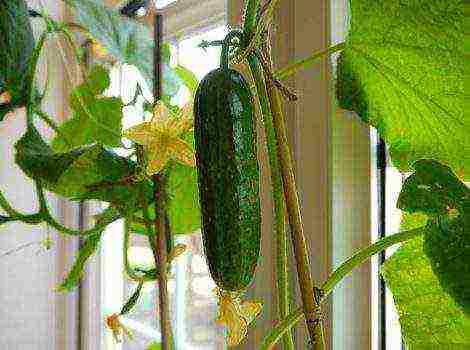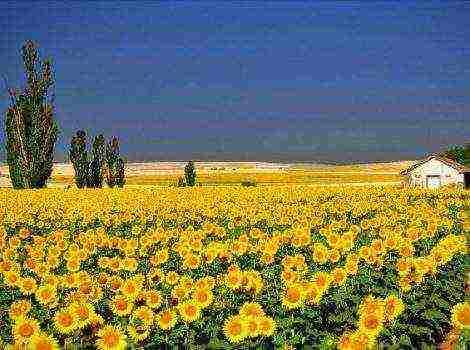Content
- 1 Proper soil preparation is the key to good germination
- 2 When to pick
- 3 Rules for caring for young myrtle
- 4 Myrtle care rules
- 5 Propagation of myrtle by seeds
- 6 Caring for myrtle at home
- 7 Growing myrtle from seeds
- 8 Propagation of myrtle by cuttings
- 9 Diseases and pests of myrtle
- 10 Types and varieties of myrtle
- 11 How to make myrtle leaf tincture?
- 12 Legends, beliefs about myrtle, its medicinal and other useful properties
If you want to grow myrtle from seeds in order to be able to observe the development of the plant from the very beginning, it should be remembered that several years can pass from the moment the sprouts appear until the first flowering. Nevertheless, many gardeners prefer to grow myrtle from seeds, which allows a better understanding of all the needs and characteristics of this plant. It all starts with preparing the soil.
Proper soil preparation is the key to good germination
Before planting, be sure to make sure the seeds are fresh and not stored for long, because the longer the shelf life of myrtle seeds, the lower the likelihood that they will sprout.

Most often, soil is chosen for sowing, made up in equal proportions of earth, humus and sand.
To improve the quality of the soil, you can add a little vermiculite, so you can better control the moisture level in the container.
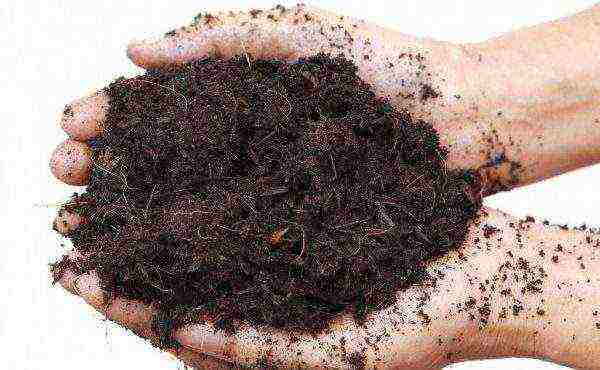
When buying a container, it will be quite enough to acquire a container about 10 cm deep. The sowing depth of myrtle seeds should not exceed 5 mm, and the sowing procedure is reduced to covering them with a thin layer of soil. After that, it is recommended to cover the container with glass or transparent plastic, place it in a room with a temperature of about 20 degrees and wait for the shoots to appear. Open the container regularly to ventilate it to avoid mold on the surface of the soil and allow it to breathe. The soil moisture level should be medium, without excessive wetting and overdrying.

If done correctly, you will see the sprouts after one to two weeks.
When to pick
A pick is made when two full-fledged leaves are formed on a young plant. The new pots must be large enough to allow for normal development and root formation of the growing myrtle.
The opinion of the gardener. After a pick, a young plant is always stressed, therefore, after planting in new pots, you should especially carefully monitor the state of the myrtle.
Do not be alarmed if growth slows down at first. With proper care, very soon the myrtle will begin to grow at its usual pace, and by the first year of life the plant will have a height of about 15 cm.
Rules for caring for young myrtle
To fully meet the needs of the plant, you need to regularly carry out:
- spraying with warm, settled water in order to maintain optimal humidity; top dressing starting from the first month of life. As a top dressing, you can use a universal flower fertilizer;
- airing the room, providing the plant with an influx of fresh air, while drafts should be avoided.
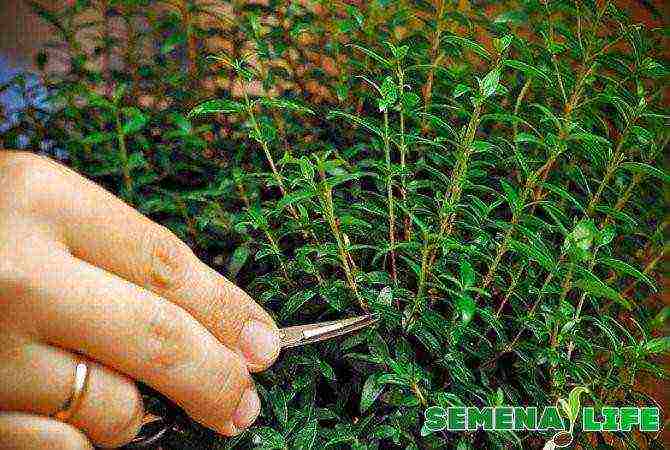
Temperature plays an important role in caring for newly emerged and growing myrtle bushes.It should not exceed 20 degrees, in such conditions the growth and formation of the bush will occur faster.
Pay attention to the quality of the water used for irrigation and spraying.
It should not be very hard, any water is best defended beforehand. If you follow these simple rules, using myrtle seeds, you can grow a beautiful and lush plant.
- How to grow myrtle at home.
- Growing myrtle from seeds.
- Proper care of seed-grown myrtle.
At home, myrtle can be grown in two ways - by cuttings and using seeds. It is better, of course, to grow myrtle from a cuttings, as this allows you to preserve the varietal properties of the plant as much as possible. But if you do not have such a tree at home, or there is no way to get a cutting, growing from seeds will also suit you.
How to grow myrtle at home
Growing myrtle on your own is not an easy task, but subject to the necessary requirements and a certain perseverance, you will succeed. The main condition for growing and caring for this plant is to maintain optimal conditions for soil moisture and indoor air.
When growing this tree, both insufficient moisture and its excess are very harmful. Lack of moisture during the growth of a plant from seed can lead to slow and defective growth, which will not allow the tree to fully develop. The plant should be watered periodically in moderation, and the foliage should be sprayed with a spray bottle.
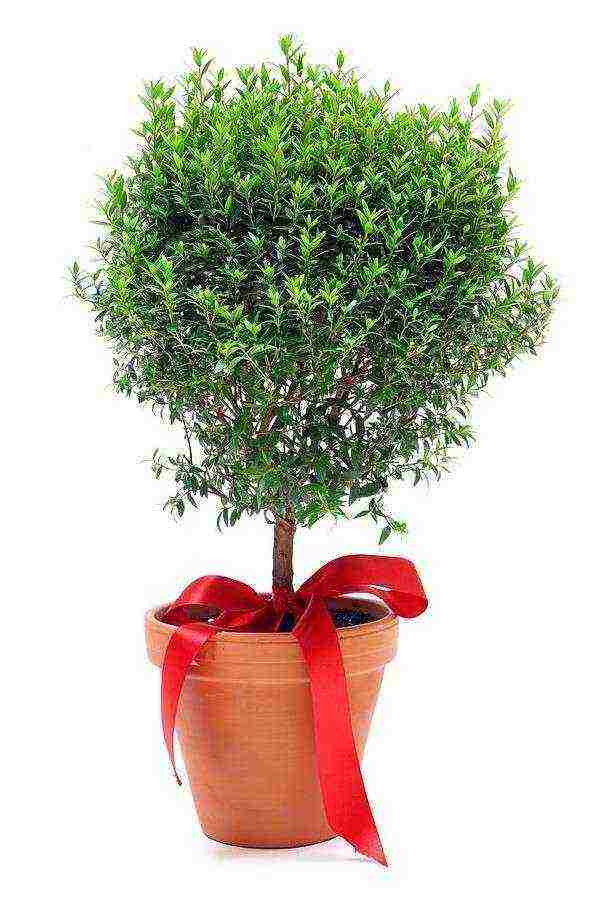
The soil for growing myrtle from seeds must meet certain requirements. The substrate should consist of humus, earth with the addition of sand, the amount of which is added in equal parts. Also, experienced plant breeders recommend adding perlite to the substrate, the amount of which should be in the region of 10-20% of the total volume of soil. This additive is excellent for growing myrtle, this is due to the fact that perlite has absorbent properties.
In the case of an excessive amount of water after irrigation, perlite will absorb excess moisture, which will not allow the rotting process to develop due to high humidity. In turn, on hot days, or if the owner forgot to water the plant in time, perlite gives off the accumulated water, which allows the plant to not dry out. Such properties of perlite make it possible to achieve uniform plant development. Also, before laying the substrate, it is necessary to make drainage, for which small pebbles are perfect.
Watch the video about the myrtle plant.
Growing myrtle from seeds
Even an inexperienced gardener can grow myrtle from seeds, since this process does not require special skills and abilities. The main disadvantage of this method of reproduction is late flowering, which occurs no earlier than four years after the descent. When choosing seeds for growing, you should pay attention to not the freshest seeds. Since the older the family, the lower the growth activity of the myrtle. Even the use of seeds older than a year will not allow achieving the optimal growth rate and full development of the tree. It is necessary to sow seeds in the soil described above, in which the process of myrtle growth will take place. But, when planting seeds, it is recommended to add peat to the substrate.
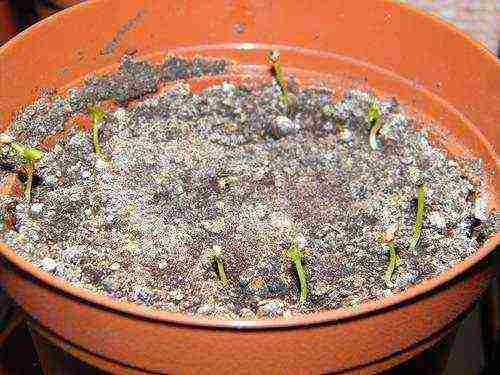
Growing myrtle from seeds at home is carried out in vessels about 10 cm deep. First, you need to fill the vessel with the main part of the soil, then place the seeds of myrtle on the surface and sprinkle them with a small layer of substrate. It is not necessary to deepen the seeds, as it does not contribute to the development, but on the contrary, it will slow down the growth of germination. The top layer should not be more than half a centimeter thick. After planting the seeds, the sowing containers must be covered with glass or plastic wrap. Then the finished sowing container must be placed in a warm place, the most optimal temperature for germination of myrtle seeds is from 18 to 20 degrees Celsius.
Under optimal conditions, the first shoots should appear within two weeks after sowing. It is necessary to transplant myrtle from seed containers into individual pots after 2 true leaves appear in the sprouts.
The first feeding can be done about a month after transplanting. For fertilization, it is recommended to use a solution of phosphate and nitrogen fertilizers. The addition of phosphate fertilizers is necessary for the full growth of leaves and flowering of myrtle, and nitrogen fertilizers for the formation of a neat small crown.
Read about taking care of your coffee tree at home.
And also about the care and varieties of room calathea.
It is possible to reproduce myrtle by seeds at any time of the year, regardless of weather conditions and air temperature outside. But experienced gardeners recommend sowing myrtle at the beginning of February, this will allow you to achieve optimal temperature conditions and the optimal amount of sunlight needed in the first month after the emergence of gatherings. It will also allow the myrtle to gradually get used to the hot summer days.
In the first years of the tree's life, it is recommended to keep it outdoors from spring to autumn. But the pot should be kept in a shaded place so that direct sunlight does not harm the leaves.
Transplanting myrtle should be carried out carefully, the main condition for such an action is a moderate deepening of the root collar into the ground. Since excessive deepening can provoke root rot and death of the tree.
Proper care of seed-grown myrtle
Caring for myrtle grown from seeds is practically the same as for plants grown by cuttings. The only difference lies in the higher susceptibility to diseases in the early stages in plants developed from seeds. Therefore, it is the first year of cultivation that requires special care.
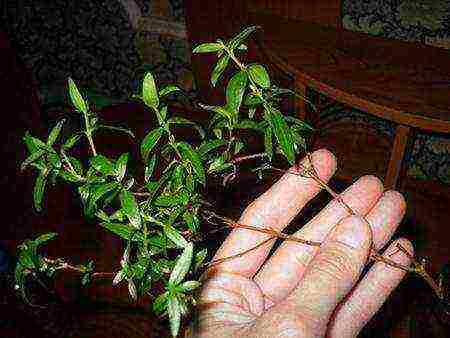
Watering should be done as often as possible, but in moderate doses. This allows you to achieve optimal conditions for the development of myrtle. Also, do not forget about feeding, which must be done based on the appearance of the plants, choosing the optimal composition and amount of feeding solution.
Share your experience of growing myrtle from seeds in the comments. And also watch a video about transplanting a myrtle plant.

Myrtle is a perennial evergreen ornamental plant, endowed not only with beauty, but also with numerous healing properties. Its decorative qualities have been known since the days of Ancient Greece. In the 20th century, the plant was deservedly called a natural healer for its ability to fight various types of microbes, including the tubercle bacillus.
At the beginning of the 19th century, several new varieties of common myrtle (Myrtus communis) were bred in the course of breeding work. Their innovation is that they can withstand short-term subzero temperatures (about 15 degrees below zero).
It is recommended to grow myrtle in the open field in regions with a temperate climate and mild winters with the lowest possible air temperature of about 8 degrees below zero.
Myrtle care rules
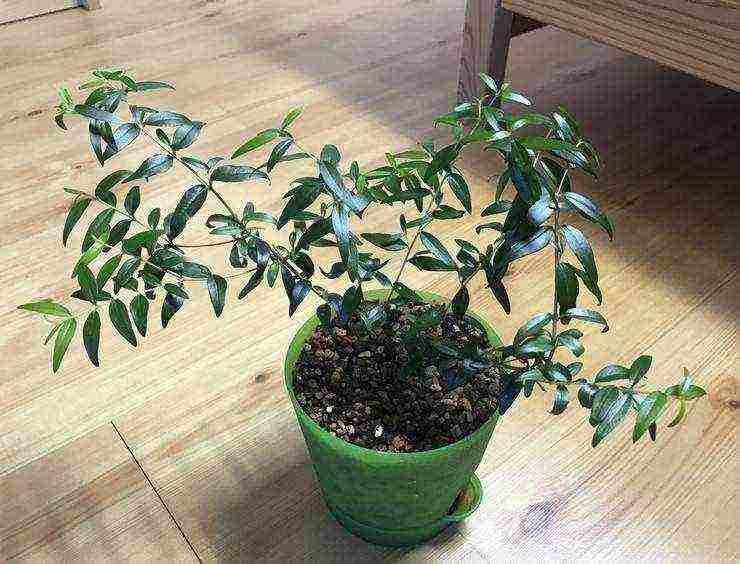
Lighting
Indoor myrtle needs full lighting. Bright light for 10-12 hours without direct sunlight is the plant's requirements. In the autumn and winter period, additional lighting with fluorescent lamps will be required.
Air humidity
The plant reacts negatively to drought and dryness of the soil, as well as to an excess of moisture in the soil. In the autumn-winter period, when various heating devices are working, the air in the room becomes dry. So that the plant does not suffer from this, it is necessary to spray 3-5 times a week or 1 time a day.
Soil composition
The optimal composition of the soil mixture for growing myrtle is earth (you can take forest, leaf or turf), humus and sand in the same amount, and approximately 10-20% of the volume of the flower container should be perlite.
Perlite or vermiculite helps to maintain a moderate level of moisture in the soil with an excess or lack of moisture during irrigation. The presence of a drainage layer in the container with the plant is also required.
Propagation of myrtle by seeds
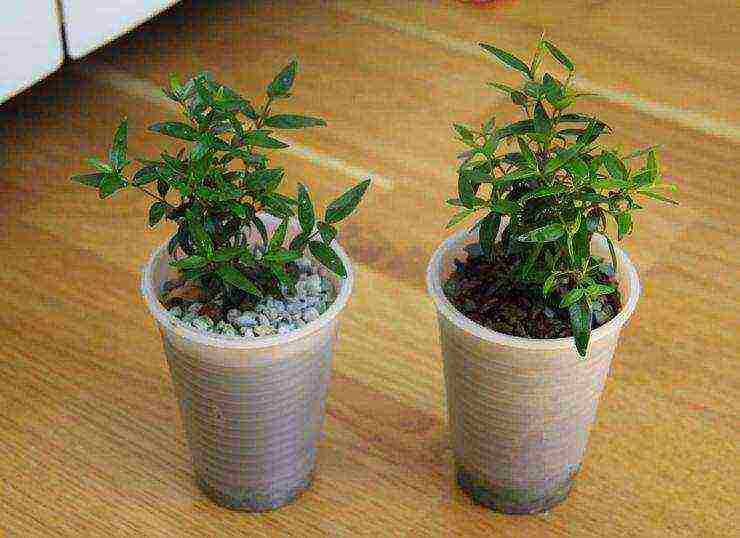
This method of reproduction is simple, but the flowering of the myrtle tree will come only after 4-5 years. Seed germination depends on their age. Freshly harvested material has the highest germination percentage, and with each subsequent year this figure decreases several times, since the seeds lose germination energy.
Planting boxes or other containers for planting seeds should be wide, but not deep - from 7 to 10 cm. It is recommended to deepen the seeds only 3-5 mm. You can scatter them over the surface, and then grind them with a small layer of soil. The landing containers must be placed in a warm room at room temperature, after having covered them with glass.
The appearance of seedlings can be expected in 10-15 days, and a pick should be carried out after 2-3 leaves appear on the seedlings. The first complex feeding - after 30 days. When transplanting, the root collar should remain above the ground.
Seed propagation can be started at any time of the year, provided there is sufficient lighting and humidity levels.
Myrtle is a plant for those who love peace, comfort and tranquility. Myrtle is an evergreen shrub or tree that belongs to the Myrtle family, which has about a hundred species. Native to the Mediterranean, myrtle grows naturally in tropical and subtropical climatic zones. In the Crimea, in the Caucasus, on the Black Sea coast, myrtle is grown in the open field as an ornamental plant. In a greenhouse, it grows up to 2 meters, but when grown in a pot, it is modest in size. The leaves of the myrtle are small, glossy, ovoid, arranged oppositely.
The trunk is ligneous, branches well. Myrtle blooms are small, solitary, white fragrant flowers. They appear in the axils of the leaves, towering on a long peduncle. Blooms from early summer. Pollinate indoor myrtle with a brush. In autumn, pollinated plants bear fruit - juicy, spicy berries of dark blue color appear. The seeds from the fruit can be used for propagation.
Having provided proper care for the plant, myrtle will delight with its decorative effect throughout the year. Unpretentious, can settle with you for a long time. It lends itself well to pruning, which allows you to form a beautiful crown in the form of a pyramid, a ball and other shapes.
Caring for myrtle at home

How to care for myrtle at home photo
Watering
Home myrtle is unpretentious in care. It will take up little space, growing will not be difficult. Provide timely watering and spraying. The plant loves moisture very much. During the period of active growth - in spring and summer - the soil should be constantly moist. During this period, it is also advisable to spray the myrtle foliage daily. Sometimes a warm shower can be arranged. Use softened, settled water for irrigation and spraying. Reduce watering as temperatures drop. In no case do not allow the earthen coma to dry out, if this happens, then the myrtle begins to dry and fall off.
Excessive watering is another destructive extreme, fraught with root rot. Avoid stagnant water in the pan and pot.
Lighting
Myrtle loves bright lighting with some direct sunlight, but shade a little at midday. If the myrtle tree is constantly kept in the shade, even providing all the other rules of care, it will not bloom. Myrtle is not afraid of drafts. On the contrary, air currents will better carry favorable phytoncides.
Temperature
The plant will thrive in cool environments. Moderate or slightly lower than moderate air temperature (within 18-23 ° C) is suitable. Maintain a cool air temperature of 6-8 ° C in winter to obtain abundant flowering. In the absence of such an opportunity, it is possible to winter in a warmer room, but with more frequent watering and spraying.
Why does myrtle shed leaves?
In winter, during the operation of heating systems, the air becomes warm and overdried - this can cause the leaves to fall off the myrtle. Do not despair, continue to water the plant moderately and by spring it will be green again. Myrtle that has undergone a warm winter will most likely not bloom. In summer, myrtle can be taken out into the open air.
Top dressing
For successful growth and good development, indoor myrtle needs to be fed. Apply organic mineral fertilizers every two weeks. During wintering, additional feeding is not needed.
How to trim and shape a myrtle crown
Under indoor conditions, common myrtle is usually grown. It tolerates pruning very well. Even if the myrtle does not bloom, the formation of the crown will allow you to grow a beautiful bonsai-type tree. Do not expose the trunk too much, because it is not very durable. Leave as many side shoots as possible. However, if you want the tree to bloom, you should not get carried away with pruning either, otherwise flower buds will not form.
Cropping myrtle on video:
Transfer
Home myrtle can grow for a very long time, it does not need to be updated every few years, like many other plants, but it is still necessary to transplant. This is done before the start of active growth - in early spring. Young plants will need an additive every year, adults as needed (every 2-3 years). A suitable substrate will be a mixture: turf soil + humus soil + peat + sand, mix in proportions 2: 1: 1: 1. Be sure to lay drainage at the bottom of the pot.
Growing myrtle from seeds

Myrtle seeds photo
Reproduction by seeds and cuttings is possible. During seed propagation, varietal characteristics may be lost if the seeds are taken from hybrid bushes. Only fresh seeds germinate well. Wash the seeds without pericarp in a weak solution of potassium permanganate, dry.
Plant in bowls using light soil. The seeding depth is 0.5 cm. Cover with foil or glass to create a greenhouse effect. Place in a warm, lit place, out of direct sunlight.
Ventilate the seedlings regularly, moisten the soil, but do not flood. Expect seedlings in 1.5-2 months, with their appearance the film must be removed. When the seedlings grow up, they are dived into separate pots. When you reach a height of 15-20 cm, you need to pinch young shoots, stimulating the growth of new ones. Myrtle grown from seeds will bloom by the 5th year of life.
Propagation of myrtle by cuttings
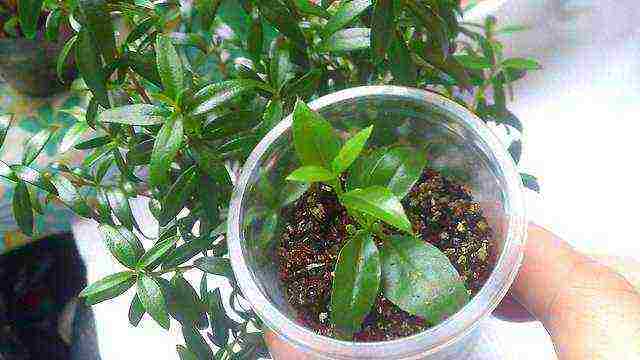
Cuttings of myrtle photo
It is easier to grow myrtle from stem cuttings. They take root very well.
- Cut off the cuttings in early summer from the upper, non-flowering shoots.
- The cutting should have 3-4 pairs of leaves.
- Approximately 1 cm of the bottom of the cutting should be immersed in a phytohormone solution and kept for about 2 hours, then rinsed with clean water.
- Plant the stalk in a wet sand-peat mixture, deepen it by three knots at an angle of 45-50 °.
- Cover the top with plastic wrap or a cut clear plastic bottle and place in a warm, shady place.
- Air the seedlings. New shoots will appear in about a month.
- Then the shelter must be removed and placed in a bright place.
In the future, take care of it like an adult plant. Such myrtle should bloom in 2-3 years.
Video about grafting myrtle:
Diseases and pests of myrtle
Myrtle diseases occur due to improper watering. It is important to constantly keep the ground moist, but avoid stagnant water in the flowerpot and pallet itself. Excessive watering can provoke the onset of root decay, which will spread further and the plant will simply die. Due to dry air and insufficient watering, foliage may turn yellow and fall off, but moderate watering will resume the plant.Also during this period spider mites can attack. You will recognize their appearance by the presence of cobwebs. Leaves, especially on the underside, need to be washed with water or a weak tobacco solution, sprayed with ground sulfur, or apply insecticides (spray outdoors).
When scale insects appear on the plant, it can secrete resin, and the leaves and stems become covered with dark spots. The plant can be treated with a soap-tobacco solution. If the scabbards are already clearly visible, soak the swab in vodka or denatured alcohol and remove the pests mechanically. Then treat with an insecticide or, more gently, with soapy water, to completely destroy the larvae.
If the leaves dry up and curl up, most likely, aphids have appeared - small insects of green, black or gray color, located on the lower part of the leaf. They multiply very quickly. Treat immediately with special preparations available from flower shops.
Types and varieties of myrtle
Common myrtle Myrtus communis

Common myrtle Myrtus communis photo
The Russian interpretation of the Latin name — Myrt Communis — is an evergreen tree that reaches a height of 50 cm to a meter in indoor conditions. Leaves are small, glossy, leathery, oblong, opposite.
Variegated Myrtle Myrtus Variegata
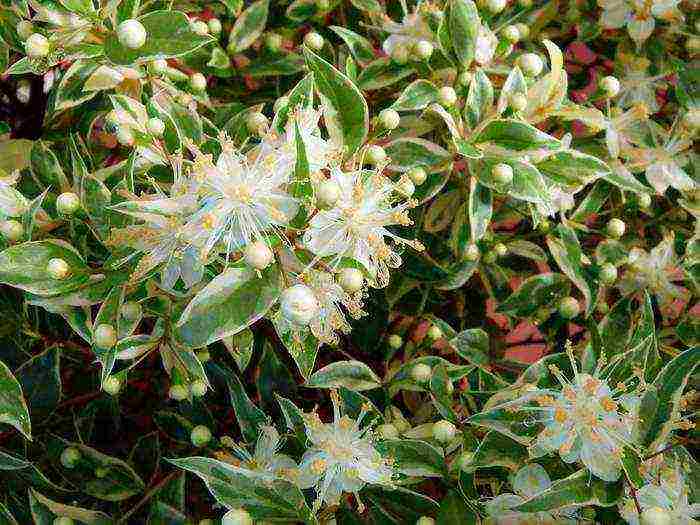
Common myrtle variegated photo
The foliage is variegated, the edges of the leaves are covered with dots and stripes of amber color. The flowers are miniature, beige and snow-white in color with golden stamens, exude a pleasant aroma. Suitable for indoor growing. This species is revered as a symbol of fertility.
The variety Myrta Hymenaeus - the name was received in honor of the God of the Marriage Union, people call him the happiness of the bride. Revered as a symbol of youth and beauty. This is an evergreen shrub, reaching a height of 3-5 m in the natural environment, and about 1 meter in a room. Leaves are miniature, lanceolate, emerald in color. The flowers are snow-white with a large number of golden stamens, 1.5-2 cm in diameter. At the end of flowering, blue-black berries are formed with an intense pleasant aroma.
Large-leaved Myrtle Myrtus macrophylla
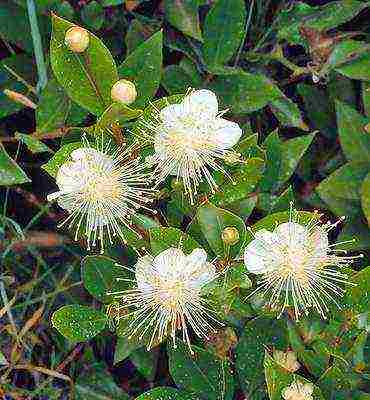
Large-leaved Myrtle Myrtus macrophylla
It has a powerful antibacterial effect, eliminating pathogenic bacteria, bacilli. Helps in the fight against flu, sore throat, sinusitis; in the prevention of treatment of gastrointestinal diseases, prostatitis.
The plant reaches a height of 3-4 m. The tetrahedral stems are covered with large leaves (up to 5 cm in length). Leaves are glossy, with pointed edges, opposite. A five-petal flower of snow-white color with symmetrical golden stamens.
Myrtus Alhambra
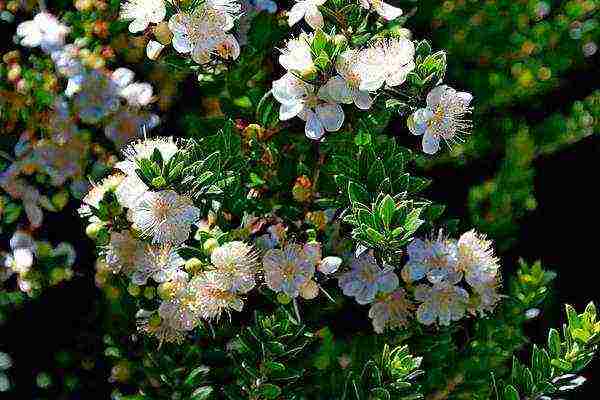
Myrtle Alhambra Myrtus Alhambra photo
An excellent ornamental plant, suitable for growing in the wild and at home. Leaves are compacted, with a high content of essential oils. The flowers are small, white, fragrant. Bloom in late spring. After flowering, white, fragrant fruits are formed.
Myrtle Tarentina Myrtus Tarentina

Myrtle Tarentina Myrtus Tarentina photo
A dwarf form of an ordinary subspecies. Small white flowers cover the plant profusely. The leaves are elongated, reaching 1.5 cm, the edges are serrated, pointed, painted in emerald color, attached to shortened petioles. The plant has a fast growth rate. In nature, it grows about 5 m high, in room conditions - up to 1 meter.
Lemon Myrtle Myrtus lemon

Lemon Myrtle Myrtus lemon photo
Delivers a pleasant lemon scent. Originally from the tropics of Australia. It is widely used in cooking. It is used to make essential oils, various sauces, dressings, syrups and lemon drinks. Dry leaves are used as a seasoning.
Small-leaved myrtle Myrtus communis microphylla

Small-leaved myrtle Myrtus communis microphylla photo
The small-leaved form of common myrtle conquers with its unique elegance with many small, densely planted dense leaves that completely cover the crown of the tree.Along with abundant flowering, it turns the myrtle tree into a festive decoration for any room.
How to make myrtle leaf tincture?
It's pretty easy to do it yourself. Take a liter jar, put about 100 g of leaves there and pour 500 g of 60-70% alcohol or vodka. For two weeks, you need to infuse the mixture in a dark place. It is advisable to shake the jar daily. Then filter the infusion. For the prevention of diseases, 30 minutes before meals, you need to take 20 drops of infusion 3 times a day.
You can benefit from the plant simply by placing it in the room: it will purify the air from various viruses and microbes. It is not recommended to put myrtle in the bedroom. You will surely love the aroma exuded by the tree. Myrtle is ideal for both home and office.
Myrtle is a symbol of a strong, prosperous, friendly family. It will be an excellent gift for newlyweds and already experienced families.
Legends, beliefs about myrtle, its medicinal and other useful properties
An ancient legend says that myrtle was brought from Paradise by Adam. The ancient Greeks considered myrtle to be sacred. Myrtle was also revered by the Romans, Egyptians, Jews. Myrtha was credited with the ability to restore youth to the aging skin of the face, and he gave strength and vigor to travelers. For Catholics, myrtle is the personification of the spirit of the Virgin Mary, therefore the peoples of Northern Europe consider it a talisman for a woman. With the birth of their daughter, a myrtle tree was grown, and at her wedding, a veil, a bride's outfit, and a wedding bouquet were decorated with sprigs of myrtle. That is why myrtle is sometimes called an unknown tree.
Myrtle means "balm" in Greek. Its flowers and leathery leaves exude phytoncides - useful substances that can not only protect the plant from diseases, but also purify the air around it, relieve fatigue, and create a positive attitude.
Myrtle essential oil is widely used in medicine and perfumery. Tincture of myrtle is used to wipe the face, which refreshes the skin better than any lotion. Myrtle tincture or a decoction of bark and leaves is used in the treatment of diseases of the throat and respiratory tract, diseases of the genitourinary system and gastrointestinal tract, treat various suppurations and poorly healing wounds.
In ancient times, the fruit of myrtle was insisted in wine, considering it a good tonic, a real elixir of health.
Be careful with folk remedies, be sure to consult your doctor. Treatment with myrtle should be used with caution in elderly people and pregnant women.
The dried fruits and leaves are used as a spice. When baking, smoking, grilling meat or fish, adding a sprig of myrtle will give them a special flavor. Remove the leaves after cooking. By the way, the clove spice is a product of one of the types of myrtle tree.

